Pre-meds improve Spanish skills
Within the fast-changing demographic of Utah and the U.S., the extracurricular Medical Unity Club at USU is working to bridge the divide between English-speaking, American doctors and their multicultural patients, said club public relations representative Chase Housley.
“Definitely right now with health care in the United States, with all the cultural differences that are happening,” Housley said, “we feel like this is such a big deal and can make such a difference in preparing future health care providers to operate in that multicultural environment.”
One of the student volunteers who helps teach at the club’s meetings, USU junior Nicole Pena, said she has been teaching Spanish medical terminology for two years.
“I got involved, obviously, because I have a Spanish background,” Pena said. “The Spanish part of it is very helpful for students because eventually they’re going to have to work with patients; and some of those patients are going to be from other cultures.”
Pena said even though elements of Spanish are being taught, the club focuses on the concept of multiculturalism as well. She said students are made aware that a wide variety of patients seek medical help, therefore it is important to have experience interacting with individuals from various backgrounds.
Arlette Dominguez, one of the regular participants in the Medical Unity Club, said the group sometimes visits the cadaver lab on campus for hands-on application of the terminology learned from the group meetings. Principal lecturer Andy Anderson, who teaches anatomy, has worked with the club to make these field trips possible. Anderson also recently gave a guest lecture on medical ethics.
“One of the things we’ve been talking about is cultural differences,” Anderson said, “how people have different cultural approaches to dealing with ethical controversies. Where does your patient come from? How do they see the world? How do they deal with medical problems?”
Other issues that healthcare professionals need to consider, Anderson said, are how people of other cultures feel about touchy subjects like abortion and physician-assisted dying. He said a lot of people go into medicine to save people’s lives and don’t give thought to the other end of the spectrum – death.
“I think the biggest support that I have for that club, I mean, look at our country, look at Utah, look at our demographic,” Anderson said. “We’re going to be dealing with Hispanic patients in greater and greater quantities. People need to know how to communicate effectively and how to approach people about important issues in medicine or ethics.”
Another guest lecturer is also one of the group’s faculty advisers, Professor Bonnie Glass-Coffin, Dominguez said. Glass-Coffin is a USU professor who teaches cultural and medical anthropology.
One of the concepts Glass-Coffin recently lectured on is the idea of ethnomedicine, which, according to her lecture notes, is the study of “culturally specific definitions of health and illness, including causes, symptoms and appropriate treatment options” for various culture-centric maladies.
“A lot of people from different countries, usually South America and Latin America,” Dominguez said, “they believe in things like mal de ojo (evil eye), things like that, that maybe a doctor doesn’t understand.”
She said these are valid ailments to the people that have them, but these kinds of sicknesses are bound to specific cultures and may not be curable by modern American medical practices.
Behind language and cultural barriers, doctors could mistakenly prescribe the wrong medications or misdiagnose patients, said Medical Unity teacher Phil Bassett. Another downfall of the divide between doctors and their multi-ethnic patients is time consumption.
“Most of your doctors now who are out there have to get a translator,” Bassett said. Translators are not always available and could be hard to find, he said.
Bassett, a student majoring in biochemistry, said he saw a billboard advertising the club and eventually volunteered to help teach. He said he served an LDS mission in Puerto Rico, which is where he learned to speak Spanish.
He said the club recently conducted a basic Spanish workshop so students with no prior experience with the language could orient themselves with it.
“Pretty much what we do is teach medical terminology and apply it, like, ‘Why would you need to learn this?'” Dominguez said.
Students from across a wide range of disciplinary studies, including biology, chemistry, Spanish and social work, attend the club, which meets on Thursdays in room 213 of the Veterinary Science Building at 4:30 p.m.
Sophomore Matt Vance, who is majoring in business administration, said he wanted to attend the club so he could meet new people. He also said he has a minor in Spanish and figured it would be a good way to broaden his vocabulary.
“Most people here (in the club) are going to med school, so this would allow them to enter the healthcare field speaking both languages and communicate more effectively.”
There are no fees to join and students from any major or minor are encouraged to attend. Housley said the group’s final meeting of the spring 2011 semester will be April 21, where they will celebrate their closing social.
“My job is to get the word out there – to make it appealing – so they can get a taste of what it’s like,” Housley said, “to see that it’s really enjoyable and they could learn a lot.”
– dan.whitney.smith@aggiemail.usu.edu

